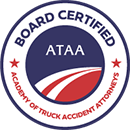Idaho Trucking Regulations
Each year, countless truck accidents occur across our state, many of which are attributable to driver errors. Below, we’ve highlighted some of the more common Idaho trucking regulations that truck drivers violate that lead to completely preventable crashes.
Our Trucking Injury Law Group team wraps up this piece by discussing your options if a truck accident caused by one of these regulatory violations left you hurt.
Idaho Truck Size and Weight Regulations
Idaho trucking regulations establish clear guidelines for what constitutes a maximum standard load and situations that call for truck drivers to apply for oversized or overweight permits.
What Is the Maximum Standard Load for Trucks in Idaho?
Limitations apply to how the sizing and weights of trucks operate in Idaho. A trucker cannot operate a semi-truck per normal that is any of the following without having to obtain an Idaho truck oversize or overweight permit:
- Have a length over 75 feet
- Be any taller than 14 feet
- Have an overhang of 4-inches in the front or 10-inches in the rear
- Exceed 8 feet 6 inches in width
- Have a GVW of more than 80,000 pounds
Any truck driver operating an 18-wheeler that extends beyond these limits must secure the above-referenced special permit before driving their commercial truck on Idaho roadways.
When Do Idaho Truckers Need To Secure an Oversized or Overweight Permit?
Anyone operating a tractor-trailer that exceeds the above-referenced criteria must apply for an overweight or oversized truck permit. However, it’s important to note that there are limitations on how much over standard guidelines a semi-truck can still be, even if its operator has a permit in hand.
Idaho truck oversize or overweight permit restrictions include that trucks must not exceed the following limits:
- A 110-foot length (if on a 2-lane road) or 115-foot length (if on a 4-lane road)
- 16 feet in width
- A GWVR of 112,000 pounds (for 5-axle trucks) or 118,000 (for 6-axle trucks)
- 14 feet 6 inches in height
In terms of overweight or oversized trucks, Idaho requires a pilot car when:
- The length of the truck exceeds 100 feet on a 2-lane road or 115 feet on an interstate
- The height of the tractor-trailer is over 16 feet
- The width of the semi-truck exceeds 12 feet 1-inch on a 2-lane road or 15 feet 1-inch on a 4-lane road
Any trucks 10 feet wide or less can drive on Idaho roads 24/7; however, other tractor-trailer operators carrying particularly large or heavy loads are restricted to driving within the window of 30 minutes pre-sunrise to 30 minutes post-sunset only.
Qualifications To Receive Commercial Driver’s Licenses in Idaho
Our state restricts who qualifies for an Idaho commercial driver’s license (CDL). Those eligible for a license to operate large vehicles like tractor-trailers require:
- S. citizenship or proof of lawful permanent residency
- Having a valid Idaho driver’s license (to operate passenger vehicles)
- A minimum of one year of driving experience
- Being 18 years old (if operating within Idaho state borders) or 21 (if driving a truck out-of-state or carrying hazardous materials within Idaho)
Getting a CDL license in Idaho is much like getting a standard driver’s license in that individuals take a written test to secure a learner’s permit and must retain it for some time before ultimately taking a skills test to secure their license. Prospective Idaho CDL license holders must also prove their understanding of how to complete a pre-trip inspection and complete a maneuvers test before being awarded their commercial license.
Do Certain Vehicles Require CDL Licenses To Drive Them in Idaho?
While it’s unnecessary for individuals operating farm, emergency, military, or recreational vehicles to secure a commercial driver’s license to do so, such a license along with special endorsements is needed if someone plans to operate one of the following large automobiles:
- Tanker truck
- Passenger bus
- Vehicles carrying hazardous materials
- A double or triple tractor-trailer
- School bus
Additionally, a CDL is required to operate any vehicle that falls into the following criteria in Idaho:
- One that can carry 16+ individuals
- One that weighs over 26,000 pounds (GVWR) by itself
- One that tows another one with a GVWR of over 10,000 pounds
Idaho Intrastate Versus Interstate Department of Transportation Number Requirements
There are two types of truckers, according to Idaho State Police (ISP). There are interstate and intrastate carriers. Intrastate carriers stay inside Idaho borders, whereas those operating both in and out of our state are interstate.
All carriers who stay within Idaho alone must obtain a state-specific intrastate Department of Transportation (DOT) number. Otherwise, a federal DOT number is required for interstate ones. Either way, the assignment of these numbers accounts for the manufacturer’s set weight rating for the truck and any units it’s hauling and other factors.






